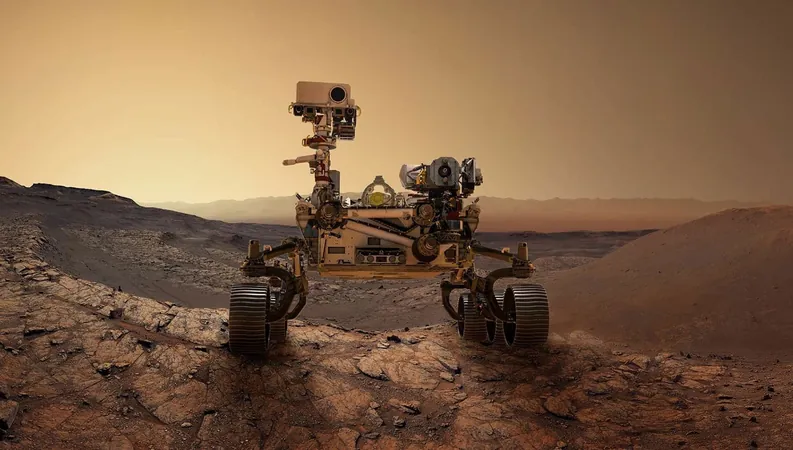
Robots: The Unsung Heroes of Human Space Exploration
2025-01-12
Author: Wei Ling
Introduction
As global attention continues to focus on challenges surrounding the International Space Station and Boeing's Starliner spacecraft, it's important to acknowledge the remarkable, yet oft-overlooked, contributions of unmanned probes to the field of cosmic exploration. While the thrilling feats of astronauts capture headlines and imaginations, much of our understanding of the universe beyond Earth has been shaped by these robotic pioneers.
The Luna 15 and Apollo 11 Missions
Back in 1969, while millions watched in awe as Apollo 11's Eagle lunar module touched down on the Moon, few recognized the significance of the Russian Luna 15 probe that had launched just days before the historic American mission. Tasked with retrieving lunar regolith and returning it to Earth, Luna 15 aimed to achieve what NASA's Apollo missions required the lives of three astronauts to accomplish. Unfortunately, Luna 15 ultimately fell short, leading to a monumental success for NASA that overshadowed the Soviet achievements, marking a pivotal chapter in the intense space race of the Cold War.
The Role of Robots in Expanding Our Understanding of the Cosmos
Fast forward to today, and the role of robots in space exploration has continued to expand exponentially. If we examine the technological advances sparked by the Apollo programme, it's clear that while human presence in space may have produced political victories, robotic missions have realigned our scientific understanding of the cosmos—accounting for discoveries that astronauts alone could not achieve. Dr. Kelly Weinersmith from Rice University, a notable biologist and co-author of the popular science book "A City on Mars," emphasizes this sentiment.
Exploring the Solar System
To date, unmanned spacecraft have visited every planet in our solar system. From the iconic Voyager 2’s encounters with Uranus and Neptune to New Horizons’ journey to Pluto, our robotic emissaries have navigated the furthest reaches of the solar system. Meanwhile, orbiters like Juno at Jupiter and the Cassini probe at Saturn have enriched our knowledge of these gas giants and their wondrous moons.
Robotic Missions on Venus and Mars
On nearer celestial bodies such as Venus and Mars, robots have successfully landed and operated on the surfaces. The Venera 7 mission first achieved a soft landing on Venus in 1970, while Mars has seen extensive exploration by rovers, including the Perseverance, which is currently preparing for NASA's ambitious Mars Sample Return mission. This forthcoming endeavor aims to collect Martian soil samples and bring them back to Earth, marking a significant milestone in our quest to understand the Red Planet.
Challenges of Distance in Space Exploration
However, the vast distances in space pose unique challenges. For example, when sending commands from Earth to Mars, a signal can take approximately 11 minutes to arrive, followed by another 11 minutes for a response—a hindrance that limits immediate reaction capabilities during critical operations. As a response to this challenge, future unmanned missions are expected to possess advanced autonomy, empowering these machines to make decisions and adapt to their environments without waiting for instructions from Earth.
The Future of Human and Robotic Collaboration in Space
Looking ahead, as we prepare for the Artemis programme aimed at returning humans to the Moon—likely paving the way for permanent human settlements—robots will play a crucial role in this new era of exploration. These intelligent machines will scout the terrain, gather vital data, and establish the groundwork for humans to follow.
Conclusion
In summary, as we look to the stars and contemplate our cosmic future, it is clear that the road to human expansion in space will be paved by the relentless endeavors of robotic technology—ensuring that when astronauts ultimately set foot on new worlds, they will do so with an arsenal of knowledge compiled meticulously by machines. The best is yet to come in the age of exploration!



 Brasil (PT)
Brasil (PT)
 Canada (EN)
Canada (EN)
 Chile (ES)
Chile (ES)
 Česko (CS)
Česko (CS)
 대한민국 (KO)
대한민국 (KO)
 España (ES)
España (ES)
 France (FR)
France (FR)
 Hong Kong (EN)
Hong Kong (EN)
 Italia (IT)
Italia (IT)
 日本 (JA)
日本 (JA)
 Magyarország (HU)
Magyarország (HU)
 Norge (NO)
Norge (NO)
 Polska (PL)
Polska (PL)
 Schweiz (DE)
Schweiz (DE)
 Singapore (EN)
Singapore (EN)
 Sverige (SV)
Sverige (SV)
 Suomi (FI)
Suomi (FI)
 Türkiye (TR)
Türkiye (TR)
 الإمارات العربية المتحدة (AR)
الإمارات العربية المتحدة (AR)